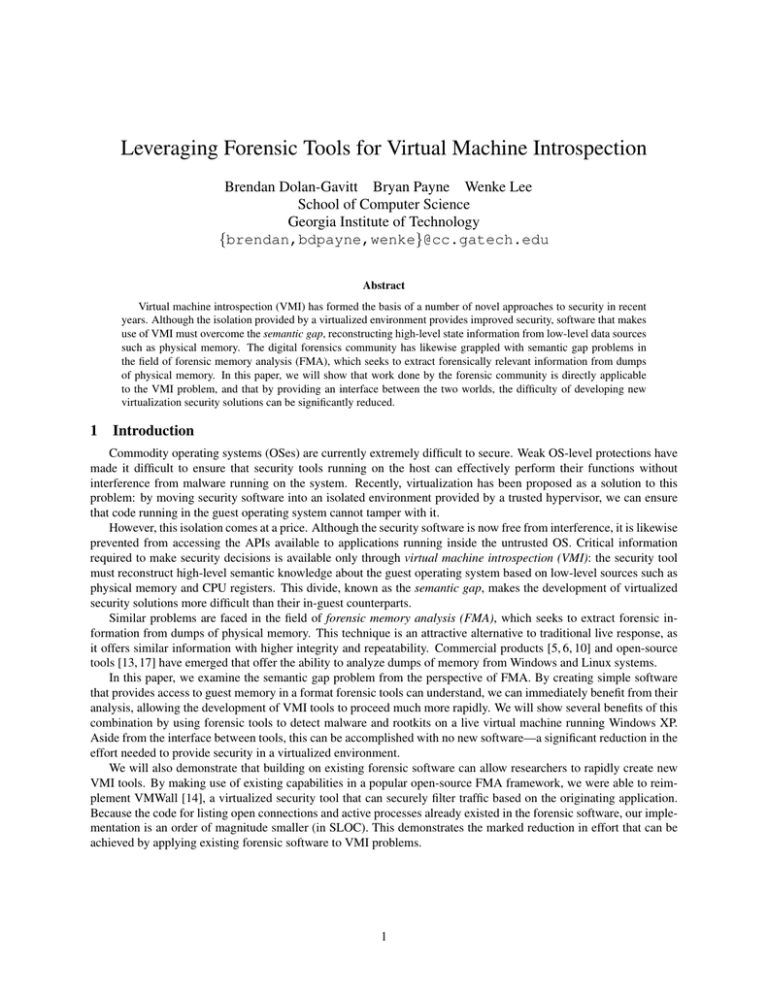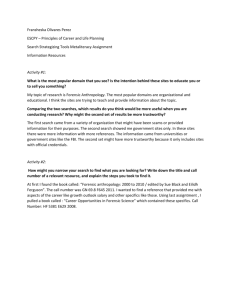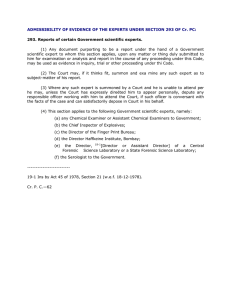Leveraging Forensic Tools for Virtual Machine Introspection
advertisement

Leveraging Forensic Tools for Virtual Machine Introspection
Brendan Dolan-Gavitt Bryan Payne Wenke Lee
School of Computer Science
Georgia Institute of Technology
{brendan,bdpayne,wenke}@cc.gatech.edu
Abstract
Virtual machine introspection (VMI) has formed the basis of a number of novel approaches to security in recent
years. Although the isolation provided by a virtualized environment provides improved security, software that makes
use of VMI must overcome the semantic gap, reconstructing high-level state information from low-level data sources
such as physical memory. The digital forensics community has likewise grappled with semantic gap problems in
the field of forensic memory analysis (FMA), which seeks to extract forensically relevant information from dumps
of physical memory. In this paper, we will show that work done by the forensic community is directly applicable
to the VMI problem, and that by providing an interface between the two worlds, the difficulty of developing new
virtualization security solutions can be significantly reduced.
1
Introduction
Commodity operating systems (OSes) are currently extremely difficult to secure. Weak OS-level protections have
made it difficult to ensure that security tools running on the host can effectively perform their functions without
interference from malware running on the system. Recently, virtualization has been proposed as a solution to this
problem: by moving security software into an isolated environment provided by a trusted hypervisor, we can ensure
that code running in the guest operating system cannot tamper with it.
However, this isolation comes at a price. Although the security software is now free from interference, it is likewise
prevented from accessing the APIs available to applications running inside the untrusted OS. Critical information
required to make security decisions is available only through virtual machine introspection (VMI): the security tool
must reconstruct high-level semantic knowledge about the guest operating system based on low-level sources such as
physical memory and CPU registers. This divide, known as the semantic gap, makes the development of virtualized
security solutions more difficult than their in-guest counterparts.
Similar problems are faced in the field of forensic memory analysis (FMA), which seeks to extract forensic information from dumps of physical memory. This technique is an attractive alternative to traditional live response, as
it offers similar information with higher integrity and repeatability. Commercial products [5, 6, 10] and open-source
tools [13, 17] have emerged that offer the ability to analyze dumps of memory from Windows and Linux systems.
In this paper, we examine the semantic gap problem from the perspective of FMA. By creating simple software
that provides access to guest memory in a format forensic tools can understand, we can immediately benefit from their
analysis, allowing the development of VMI tools to proceed much more rapidly. We will show several benefits of this
combination by using forensic tools to detect malware and rootkits on a live virtual machine running Windows XP.
Aside from the interface between tools, this can be accomplished with no new software—a significant reduction in the
effort needed to provide security in a virtualized environment.
We will also demonstrate that building on existing forensic software can allow researchers to rapidly create new
VMI tools. By making use of existing capabilities in a popular open-source FMA framework, we were able to reimplement VMWall [14], a virtualized security tool that can securely filter traffic based on the originating application.
Because the code for listing open connections and active processes already existed in the forensic software, our implementation is an order of magnitude smaller (in SLOC). This demonstrates the marked reduction in effort that can be
achieved by applying existing forensic software to VMI problems.
1
Runtime Analysis Using
Virtual Machine Introspection
Forensic Memory Analysis
Physical
Memory
Other filebased tools
Memoryze
FUSE
Interface
Other filebased tools
Memoryze
Live Access
Snapshot
Volatility
Volatility
PyXa
Interface
XenAccess
Introspection
Library
Physical
Memory
Dump
File On
Disk
Figure 1: Both virtual machine introspection (VMI) and forensic memory analysis (FMA) start with the same view of
memory. One of the main differences is that VMI operates at runtime whereas FMA is static. Even so, the same tools
can be used to address the semantic gap problem in both settings.
2
Related Work
Virtual machine introspection has been a critical part of many recent virtualization-based approaches to security.
First introduced by Garfinkel and Rosenblum [4], introspection allows security software to gain an understanding of
the current state of the guest virtual machine. APIs such as XenAccess [11] and VMSafe [16] have appeared that
can be used to provide the low-level access required to read the virtual machine state, and researchers have created
applications ranging from intrusion detection systems [4] and firewalls [14] to malware analysis frameworks [1,7] and
zero-day attack analysis platforms [9].
On the forensic side, work has focused on finding ways to bridge the semantic gap and recover security-relevant
artifacts from physical memory. These efforts have resulted in tools that are able to find processes and threads [13],
detect DLL injection [18], recover files mapped in memory [15], and extract information about the Windows registry
[2]. Although this work does not solve the semantic gap problem in general, it provides valuable insight into the
internals of widely deployed operating systems that can provide critical data for security tools.
Our own work unites these two fields, showing how the work done by the forensic community can be directly
applied to the problems of virtual machine introspection. By demonstrating several interfaces between forensic tools
and virtual machines, we hope to ease the difficulty of introspection and spur the creation of new tools.
3
Comparing FMA and VMI
VMI software runs in an isolated virtualized environment and monitors the state of other VMs. This isolation
protects it from tampering by software inside the monitored VM, making it an attractive way to implement security
software. VMI-based monitoring is performed online and focuses on detecting security events as they occur. FMA,
by contrast, typically takes place after a security incident is suspected to have occurred. An investigator acquires an
image of physical memory and then performs offline analysis, extracting information about the system state to explain
the incident. In this section, we will examine the key similarities (shown in Figure 1) between these two fields that
allow approaches developed for FMA to be used for VMI.
In order to reconstruct information about the state of the OS, both approaches rely primarily on physical memory
as a source of data. However, modern operating systems operate using virtual memory; thus, to appropriately interpret
OS-level data structures, VMI and FMA applications must be able to translate virtual addresses to their physical
location in memory. On x86-based systems, a set of page tables are used to perform the virtual-to-physical mapping.
Once the page tables for the kernel address space are located, virtual memory becomes accessible and more meaningful
data about the state of the system can be extracted.
Both VMI and FMA applications must deal with semantic gap issues. Because native OS APIs are not available,
information about the state of the system must be gathered by locating and examining the internal data structures
that the in-guest APIs use. This is currently a difficult and manual process, particularly on closed source operating
systems such as Windows, where details of data structures must be obtained through reverse engineering. Because
both virtual machine introspection and forensic memory analysis examine physical memory, advances made by the
forensic community in understanding these structures can be directly applied to virtualization security.
The advances made by the forensic community in reconstructing high-level state from physical memory dumps are
not entirely general, however. Most work has focused on recovering information about specific operating systems and
versions; in particular, many FMA tools currently only support Windows XP with Service Pack 2. Although support
2
for other operating systems is increasing (some commercial tools support multiple versions of Windows, and several
open-source FMA frameworks now support Linux), FMA does not provide a complete solution to the semantic gap
problem. In the absence of a general solution, however, the information provided by FMA can enable a variety of new
VMI applications and allow researchers to avoid duplicating effort when implementing new systems.
Because VMI examines a live system, it also has access to information beyond what is available in a forensic
context. In addition to the static view of physical memory provided by a memory dump, VMI applications can watch
the state of the system as it changes over time. This allows the use of techniques that are not possible in offline
analysis: for example, Antfarm [8] tracks the value of the CR3 register (which holds the address of the page directory
for the current active process) to determine what processes are running inside the virtual machine. Since a memory
image gives a view of the system state at a single point in time, this technique will only work in a live environment.
Although much of the same information is available with both VMI and FMA, there are some difficulties associated
with virtual machine introspection that are not present with offline forensic analysis. Because the system is still
running, the CPU and memory state will change as analysis is performed unless the CPU is suspended before analysis
(which can negatively impact performance). By contrast, FMA tools need only be concerned with memory volatility
at the time the snapshot is taken: although the system continues to run throughout the acquisition process, the results
are static and can be examined offline.
Despite these differences, forensic memory analysis tools can be of great value to virtual machine introspection. As
we will show, work done in the forensic community to bridge the semantic gap can be directly applied to the problems
faced by introspection (though the converse is not necessarily true). By applying forensic tools and techniques in a
virtualized setting, we can reduce the time needed to develop new virtualization security applications.
4
Forensic VMI Interfaces
To make use of forensic tools for VMI, the forensic software needs to access the memory of the guest virtual
machine (VM). There are two ways to accomplish this: modifying existing forensic software to extend its capabilities
and presenting the memory of a guest VM in a format that FMA tools can understand. The former would allow FMA
software to take advantage of the live nature of VMI; however, the latter requires no modifications to existing tools.
We have implemented two general methods for allowing existing applications to interface with the memory of a
guest virtual machine as a filesystem interface and an extension API. The filesystem interface exposes guest memory
as a regular file on the host, allowing FMA tools that process memory dumps to operate on guest memory with no
modifications. The extension API requires a small number of changes to the forensic software to enable access to guest
memory using an introspection library such as XenAccess [11]. Although the filesystem interface is more general, the
extension API can provide a forensic tool with additional information that may improve its analysis capabilities. Both
interfaces have been freely released as part of XenAccess so they can benefit other researchers.
Both interfaces are built on top of XenAccess, which does the actual work of reading the guest physical memory.
We built a Python C extension around this library called PyXa, which presents a Xen VM as a Python object with
a read method that reads a single page of physical memory from the guest, and a helper method get cr3 that
retrieves the current value of the CR3 register from the guest’s virtual CPU. We created this wrapper in Python to
allow prototype VMI applications to be built more quickly and because the most popular open-source memory analysis
tool, Volatility [17], is written in Python. Volatility can enumerate active processes, open network connections, loaded
kernel modules, and other data that are relevant to both VMI and FMA.
The filesystem interface was implemented using FUSE [3], a library that allows filesystems to be built without
writing kernel code. Because FUSE filesystems can be written in high-level languages such as Python, we were able
to write a filesystem that uses PyXa to expose guest memory as a regular file in just 156 SLOC. When an application
attempts to read from the file, FUSE calls the read method of our pseudo-file, which in turn calls PyXa’s read
method to read the requested data from the guest’s physical memory. This allows any application to treat virtual
machine memory as though it were a regular memory image on disk.
Because the filesystem interface presents the guest’s memory as a file, no changes to forensic applications are
required. However, this simple interface does not provide any extra information from VMI that might be useful to
FMA tools. To allow forensic applications to benefit from additional knowledge such as the state of CPU registers,
we extended an existing open-source memory analysis framework, Volatility, to access virtual machine memory by
interfacing directly with PyXa. This extension to Volatility (≈ 80 SLOC) allows the forensic framework to access the
CR3 register and begin performing virtual address translation immediately; normally, a scan of physical memory is
required to locate the initial page directory and bootstrap the address translation process.
3
PID for the malicious
click fraud traffic
Process information associated
with the PID found above
Functions hooked by the
Haxdoor rootkit through the
system call table
Kernel driver installed by
the Haxdoor rootkit
Figure 2: (Left) Detecting which process is responsible for click fraud network traffic using XenAccess for virtual
machine introspection and Volatility to interpret the raw memory data. (Right) Rootkit detection on a running host
using Memoryze connected to a virtual machine introspection backed file.
These two interfaces can provide a rich, high-level view into the state of the guest virtual machine. As we will
see in the next section, these simple interfaces allow many introspection-based security applications to be trivially
realized with off-the-shelf forensic software. Process and threads can be enumerated using PTFinder, open files and
active network connections can be examined using Volatility, and commercial memory analysis software such as
Memoryze [10] and HBGary Responder [6] can be used to detect rootkit activity in the guest VM.
5
Application Examples
Bridging the semantic gap opens the door to many new applications. Even though the forensic memory analysis
applications and libraries discussed above do not provide the same rich application programmer interfaces (APIs) that
are provided by the operating system, they do provide enough information to enable the rapid development of useful
security applications. In this section, we show two ideas that can be rapidly built using PyXa and the FUSE module.
However, these ideas are simply examples to illustrate the utility of this approach. The information available through
forensic memory analysis tools enables the exploration of a wide variety of security applications.
5.1
Identifying the Source of Malicious Network Traffic
Using PyXa to connect Volatility to XenAccess, we are able to extract a wide variety of information from a running
Windows XP VM. This information includes any open connections, a list of the running processes, DLLs loaded for
each process, open files for each process, kernel modules, open sockets, thread objects, and more. Using the list
of open connections, combined with the list of running processes, we can identify which process inside the VM is
responsible for particular network traffic leaving the VM.
For this scenario, we assume that some existing mechanism can be used to detect malicious or unusual network
traffic leaving the VM. For the purposes of our testing, we generated this malicious traffic by installing bots inside the
VM. The bots we used included click fraud bots, spam bots, and trojans (DR/Click.Delf.BW, AdClicker-AD,
DR/Click.HSP.A.2, AdClicker-BY, Spammer:Win32/Cutwail.gen!B, Trojan.Inject.IA, and
Trojan:Win32/Waledac.gen!A). In each case we first identified the malicious network traffic using a network
packet analyzer. Next, using Volatility on the running VM, we identified the open connection associated with this
network traffic and the process responsible for the open connection. In each case, we were able to identify the process
responsible for the malicious traffic. Figure 2 shows the output produced while running DR/Click.Delf.BW.
Volatility is designed to be a tool operated from the command line. However, with some simple modifications, it
can also be used as a Python library. As a result, the type of investigation described above can be automated, resulting
in a network firewall that allows or denies traffic based on the process that produced the traffic. This functionality
is essentially the same as VMWall [14]; however, by leveraging the semantic information provided by Volatility this
application can be written much more quickly.
To demonstrate this point, we wrote a Python script that uses the user-space packet filtering feature of iptables
to make decisions about whether to allow or deny packets based on the originating application. When a packet is
sent from the guest VM, its source and destination IP and ports are extracted, and Volatility is used to determine
4
the originating application. An application whitelist is then used to decide if the packet is allowed onto the external
network. By making use of existing code in Volatility, this prototype took only 68 SLOC in Python and about an hour
of labor to implement. By contrast, the source code to VMWall (written in C) consists of 1094 SLOC.
5.2
Rootkit Detection
Many FMA tools are not able to integrate with XenAccess using PyXa. This includes FMA tools that are not
written in Python, that are not open source, or that access memory through another abstraction. One abstraction
commonly used with FMA tools is to work from a single file containing a physical memory dump. As described in
Section 4, our filesystem interface provides this abstraction, allowing the use of many FMA tools to operate on a live
system using VMI. One such tool is Memoryze, a freeware product by Mandiant [10].
Memoryze finds rootkits by identifying hidden drivers and hooks in the system call table, interrupt descriptor tables
(IDT) and driver function tables (IRP). To demonstrate this capability working on a running system using our FUSE
adapter running with XenAccess, we installed several rootkits inside the VM (Trojan:Win32/DriverBypass,
Backdoor:Win32/Haxdoor, Trojan.Dropper.Farfli.G). After installing each rootkit, we ran the
HookDetection.bat script provided by Memoryze, using our FUSE adapter as the input file. For each rootkit
that we tested, we detected system call table hooking. The Trojan:Win32/DriverBypass rootkit also used IRP
hooking. Figure 2 shows the output produced while running Backdoor:Win32/Haxdoor.
6
Discussion
The two applications described above are intended solely to demonstrate the possibilities of integrating FMA tools
with VMI. We do not view the specific applications as being novel. Instead, we emphasize that these applications were
built very rapidly by leveraging the semantic knowledge contained within the FMA tools. Given the ease with which
they were built, it is notable that each test case resulted in detecting and acquiring additional information about the
malware. Indeed, we view this as an indication that the overarching idea of malware detection on a running machine
using VMI is a powerful and promising direction warranting further research.
The semantic gap continues to pose significant problems for researchers working with VMI. Now that the foundations have been laid for using VMI in real world applications with both passive [4, 11] and active [1, 12] monitoring,
researchers are working on applications that utilize this technology. However, for each application researchers are
spending a significant amount of time addressing the semantic gap problem. The result is often a solution involving
many static, hard-coded values that allow prototype code to work on a narrow set of applications or operating systems. Using the techniques that we describe in this paper, researchers can more easily focus on the creation of their
applications without being encumbered by the semantic gap issue.
We readily acknowledge that the FMA tools do not represent a general solution to the semantic gap problem.
There is still a significant amount of research to be done to resolve the semantic gap problem. Existing solutions, such
as the FMA tools, provide a relatively small amount of information when compared with the complete set of operating
system and application level programmer’s interfaces typically available in a modern system. There is also a need
to provide coverage across a wider set of software versions, perhaps even automating the memory analysis process
to allow support for new software versions. In addition, future security applications will need to monitor application
memory as well as operating system memory. There are still a variety of open, hard problems to solve before we will
have a general solution to the semantic gap problem.
Until there is a general solution to the semantic gap problem, the FMA tools are the best option available to
security researchers. In many cases, the information provided by these tools is sufficient to enable the rapid creation
of research prototypes. Using this technique, researchers can continue to explore applications that use VMI while the
orthogonal semantic gap problem is being addressed. In cases where the information provided by existing FMA tools
is insufficient to support a security application, one can still choose to extend an existing FMA tool. For example,
writing a module for Volatility allows one to build on top of the semantic information already provided in Volatility.
Either way, using FMA tools to assist with VMI saves time and limits the amount of redundant work.
7
Conclusion
A significant amount of recent security research has focused on using virtual machine introspection to create security applications that can operate with some degree of isolation from malware. These applications must overcome the
semantic gap problem by interpreting the target system’s memory to understand high-level details about the system’s
5
operation. This semantic gap problem remains a difficult, open research problem today. However, working and publishing separately from the traditional security conferences, the digital forensics community has put significant effort
into developing systems to extract information from physical memory snapshots. In this paper, we demonstrated that
these forensic systems can be used as a partial solution to the semantic gap problem when accessing running systems through virtual machine introspection. As a result, security researchers using these techniques can more rapidly
develop prototype software and test their research ideas.
References
[1] A. Dinaburg, P. Royal, M. Sharif, and W. Lee. Ether: Malware analysis via hardware virtualization extensions.
In Proceedings of the ACM Conference on Computer and Communications Security, 2008.
[2] B. Dolan-Gavitt. Forensic Analysis of the Windows Registry in Memory. In Proceedings of the Digital Forensic
Research Workshop (DFRWS), 2008.
[3] FUSE. FUSE: Filesystem in userspace. http://fuse.sourceforge.net/.
[4] T. Garfinkel and M. Rosenblum. A Virtual Machine Introspection Based Architecture for Intrusion Detection. In
Proceedings of the Network and Distributed Systems Security Symposium, 2003.
[5] G. M. Garner. KnTTools. http://gmgsystemsinc.com/knttools/.
[6] HBGary. Responder Pro: Physical Memory and Malware Analysis Application. https://www.hbgary.
com/products-services/responder-professional/.
[7] X. Jiang, X. Wang, and D. Xu. Stealthy Malware Detection Through VMM-Based “Out-of-the-Box” Semantic
View Reconstruction. In Proceedings of the ACM Conference on Computer and Communications Security, 2007.
[8] S. T. Jones, A. C. Arpaci-Dusseau, and R. H. Arpaci-Dusseau. Antfarm: tracking processes in a virtual machine
environment. In Proceedings of the USENIX Annual Technical Conference, 2006.
[9] A. Joshi, S. T. King, G. W. Dunlap, and P. M. Chen. Detecting past and present intrusions through vulnerabilityspecific predicates. In Proceedings of ACM Symposium on Operating Systems Principles, 2005.
[10] MANDIANT. Memoryze. http://www.mandiant.com/software/memoryze.htm.
[11] B. D. Payne, M. Carbone, and W. Lee. Secure and Flexible Monitoring of Virtual Machines. In Proceedings of
the Annual Computer Security Applications Conference, 2007.
[12] B. D. Payne, M. Carbone, M. Sharif, and W. Lee. Lares: An Architecture for Secure Active Monitoring Using
Virtualization. In Proceedings of the IEEE Symposium on Security and Privacy, 2008.
[13] A. Schuster. Searching for processes and threads in Microsoft Windows memory dumps. In Proceedings of the
6th Annual Digital Forensic Research Workshop (DFRWS), 2006.
[14] A. Srivastava and J. Giffin. Tamper-resistant, application-aware blocking of malicious network connections. In
Proceedings of the International Symposium on Recent Advances in Intrusion Detection, 2008.
[15] R. van Baar, W. Alinka, and A. van Ballegooija. Forensic memory analysis: Files mapped in memory. Proceedings of the Digital Forensic Research Workshop (DFRWS), 2008.
[16] VMWare, Inc. VMWare VMSafe security technology.
security/vmsafe.html.
http://www.vmware.com/technology/
[17] A. Walters. The Volatility framework: Volatile memory artifact extraction utility framework. https://www.
volatilesystems.com/default/volatility.
[18] A. Walters. FATKit: Detecting Malicious Library Injection and Upping the “Anti”. Technical report, 4TΦ
Research Laboratories, July 2006.
6





